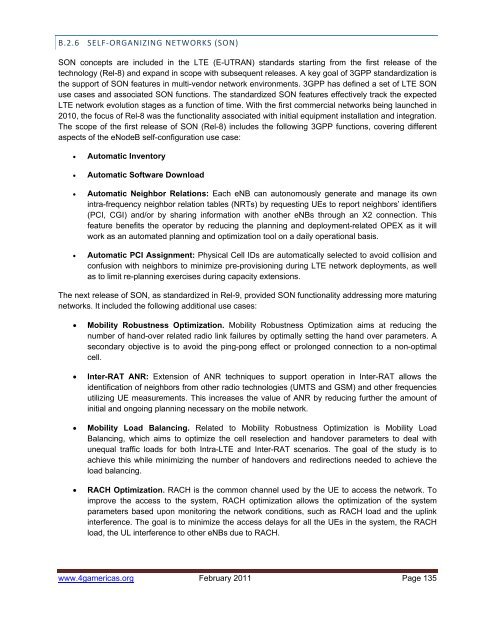Create successful ePaper yourself
Turn your PDF publications into a flip-book with our unique Google optimized e-Paper software.
B.2.6 SELF‐ORGANIZING NETWORKS (SON)<br />
SON concepts are included in the LTE (E-UTRAN) standards starting from the first release of the<br />
technology (Rel-8) and expand in scope with subsequent releases. A key goal of 3GPP standardization is<br />
the support of SON features in multi-vendor network environments. 3GPP has defined a set of LTE SON<br />
use cases and associated SON functions. The standardized SON features effectively track the expected<br />
LTE network evolution stages as a function of time. With the first commercial networks being launched in<br />
2010, the focus of Rel-8 was the functionality associated with initial equipment installation and integration.<br />
The scope of the first release of SON (Rel-8) includes the following 3GPP functions, covering different<br />
aspects of the eNodeB self-configuration use case:<br />
� Automatic Inventory<br />
� Automatic Software Download<br />
� Automatic Neighbor Relations: Each eNB can autonomously generate and manage its own<br />
intra-frequency neighbor relation tables (NRTs) by requesting UEs to report neighbors’ identifiers<br />
(PCI, CGI) and/or by sharing information with another eNBs through an X2 connection. This<br />
feature benefits the operator by reducing the planning and deployment-related OPEX as it will<br />
work as an automated planning and optimization tool on a daily operational basis.<br />
� Automatic PCI Assignment: Physical Cell IDs are automatically selected to avoid collision and<br />
confusion with neighbors to minimize pre-provisioning during LTE network deployments, as well<br />
as to limit re-planning exercises during capacity extensions.<br />
The next release of SON, as standardized in Rel-9, provided SON functionality addressing more maturing<br />
networks. It included the following additional use cases:<br />
� Mobility Robustness Optimization. Mobility Robustness Optimization aims at reducing the<br />
number of hand-over related radio link failures by optimally setting the hand over parameters. A<br />
secondary objective is to avoid the ping-pong effect or prolonged connection to a non-optimal<br />
cell.<br />
� Inter-RAT ANR: Extension of ANR techniques to support operation in Inter-RAT allows the<br />
identification of neighbors from other radio technologies (UMTS and GSM) and other frequencies<br />
utilizing UE measurements. This increases the value of ANR by reducing further the amount of<br />
initial and ongoing planning necessary on the mobile network.<br />
� Mobility Load Balancing. Related to Mobility Robustness Optimization is Mobility Load<br />
Balancing, which aims to optimize the cell reselection and handover parameters to deal with<br />
unequal traffic loads for both Intra-LTE and Inter-RAT scenarios. The goal of the study is to<br />
achieve this while minimizing the number of handovers and redirections needed to achieve the<br />
load balancing.<br />
� RACH Optimization. RACH is the common channel used by the UE to access the network. To<br />
improve the access to the system, RACH optimization allows the optimization of the system<br />
parameters based upon monitoring the network conditions, such as RACH load and the uplink<br />
interference. The goal is to minimize the access delays for all the UEs in the system, the RACH<br />
load, the UL interference to other eNBs due to RACH.<br />
www.4gamericas.org February 2011 Page 135

















